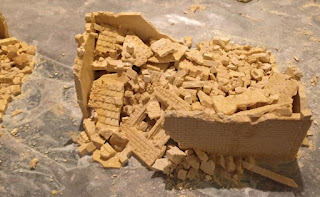I've been experimenting with terrain construction techniques for a while, and figured it was time for a catch all post.
First, behold the power of enamel paints! One of the best new methods I've found for painting is just dumping acrylics and switching to enamels. What you see here are a few examples of enamels in action.
Like many WWII war gamers, I couldn't resist buying some pre-painted 4Ground buildings. Rather than keep well enough alone, I've been upgrading them. First I played with acrylic washes, but recently I have been using enamel washes instead. I make these by taking thinner + Humbrol enamel paint and mixing it into a milky consistency. The results are spectacular for brickwork. The cafe above benefited from a white enamel wash used to shade the mortar. I'm really happy with the effect. So much so, that I've decided I have to replace the roof sections with more detailed casts. I'll show that later.
The last two photos are of some dental plaster casts I am playing with. I found a new plaster called Excalibur, which produces incredibly strong casts. It is much stronger than Magic Merlin. I've actually dropped pieces of my cast and had them survive without chipping. What I am building is a series of row houses from Arnhem. We'll circle back to Arnhem after my Pegasus bridge table is completed, but I liked where the casting was going and wanted to show the building. Each floor is removable as well, including a cool attic perfect for snipers. I should probably make some stairs in order complete the detail, but for now residents will have to use ropes to change levels. Besides, it makes it easier to place models inside.
Just wait till you see the destroyed buildings! (all those bad casts are useful after all)

















































